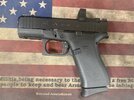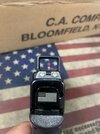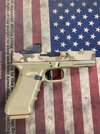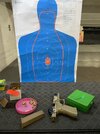Michael Tinker Pearce
Member
- Joined
- Oct 23, 2016
- Messages
- 1,577
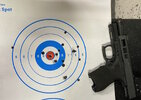
Fast double taps at 7 yards. Probably would have been more centered if I'd zeroed the optic...
In a lot of ways an RDS is a better mousetrap. They've dominated speed-shooting competitions for decades, they allow better situational awareness, help prevent tunnel vision, put the sight in the same visual plane as the target etc. But they've been expensive and you need to spend even more money getting a slide cut for them. Now this is changing and a lot of guns come with an RMR cut and the sights are getting cheaper. When a company offered to send me a sight to review I said yes. Of course I needed a gun to review it... Enter the PSDA Dagger Compact. A buddy had an unfired gun and wanted something I had so we swapped. I tested the optic on that and another gun and it functioned as advertised and held zero through moderately unreasonable abuse, I did the review and moved on.
Of course now I had an RDS mounted on a pistol and figured it was time to learn to use it decently.
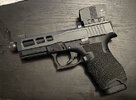
After forty years of iron sights and the Flash Sight Picture it's harder than you might expect. In fact it's about as hard as I expected. Slow-fire on the range is a doddle. Rapid sight acquisition is a bit harder and takes some work. If you're me, I mean. I'm working on it and the most successful method I have found so far it to simply point the gun with both eyes open and if I do it right the dot appears in my field of vision. Seems simple but it's a very different skill than rapidly acquiring the front sight and centering it in the rear sight while maintaining a laser-sharp focus on the front sight. It takes patience and practice. So I am doing that. It would help if the optic worked with the co-witness sights I think, but it's too tall. So I keep working on it.
Fortunately it seems this skill isn't a replacement for four decades of experience; it's additive. It does not change or interfere with my iron sight skill set; it's a different animal altogether. I'm old but I can still learn new things so I'll keep working at it and no doubt there are more RDS in my future.


